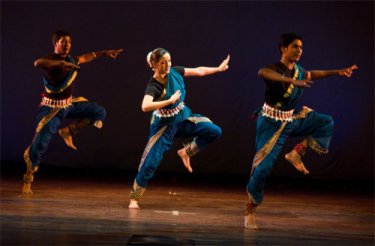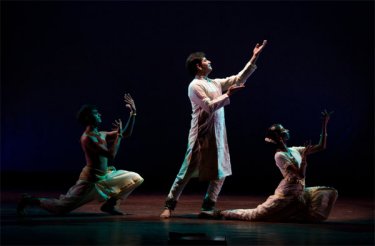
|   |

|   |
Shivaya: An ode to the dancing Lord - Priya Raman, Hyderabad e-mail: priyans03@gmail.com Photos: Amith Nag January 16, 2011 Somebody once questioned a dancer "Why did Shiva dance?" An intriguing question, it did not find an immediate answer, but introspecting on it, I feel Shiva danced so that he could commission blessed messengers like us to dance in life, make an eminent living for ourselves and those associated with it. So when some of these blessed messengers offer it back to Shiva, it is bound to be special. Malathi Iyengar, Director of the Rangoli Foundation for Arts and Culture, USA conceived and presented 'Shivaya,' an ode to the Lord, which was so special that it would have in all its true essence reached the Lord at the earliest. 'Shivaya' originally premiered in Los Angeles in August 2010 was presented in India by the Nadam Dance Company (Nandini Mehta and Murali Mohan) in Bangalore at the JSS Auditorium on 25th December 2010. The team travelled all the way from Los Angeles to collaborate with dancers from Chennai and Bangalore to pay tribute to the Panchakshara Mantra - 'Om Namah Shivaya' and to the five elements, to stillness and to movement.
As we braced ourselves against Bangalore's thick fog and mist to reach early morning rehearsals, Malathi Iyengar with her razor sharp time sense would be her fresh self, all geared to get it all right and perfect. Her uncanny ability to strike the right chord with professionals kept the spirits high among a team of youngsters where otherwise there inevitably would arise ego issues! She brought in a strange discipline adopted from the west to make things as simple as they can get. The theme was abstract, yet sound and so it took a whole two days to get into the groove. I have seen group work but this re-defined the term in the sense that it had artistes from across India with their own styles but practiced to look similar. Being a small part of the production helped to watch most of the production with an outer eye for it had edupu jathis and korvais in all the items and just the required abhinaya and elaboration in the sanchari bhavas was simple and authentic. And I must mention people who trained me would have taken a sigh of relief after the program for I had a tough time getting used to the intricate jathis and very, very different adavu patterns!   Every move, every look and every hasta was coordinated to the last degree with a personalized effort yet giving each dancer the space to perform individually. Attention to detail was something to watch out for in this formalist to the core as she patiently explained every exit and entry to the in house technicians of the auditorium to get the desired 'wow factor.' Malathi Iyengar had the best people in the business work together - Rajkumar Bharathi, Embar Kannan, Praveen Rao, Gurumurthy G, Srihari Rangaswamy and other traditional composers and hardworking dancers putting their best foot forward. The dancers, professional, as they were, rehearsed with brain storming sessions of ideas and mutually amicable ways to make the presentation better. There was this strange aura of open mindedness in blending different techniques, styles and thinking to make working fun all together. The production was a theme revolving around presenting the five elements - Water, Air, Fire, Earth and Sky indicatively, through abstract choreography and a mix of vibrancy and variety. It was preceded by a Pushpanjali by Lucrezia Maniscotti, one of the company's dancers giving the conventional start, a group presentation for the Devaranama -'Chandra Chooda Shiva Shankara Parvathi' - a Kathak performance by Murali Mohan and the audience were witness to Rangoli Foundation's journey in a pre-designed video of its achievements. An item encompassing the Chhau martial art focusing on the peacock commenced Shivaya and the peacocks brought rain to show Amruthavarshini, the joy of rain. Another popular composition 'Nagendra Haraya' was presented by three male dancers and had two little surprises in Chirag Sumathi and Dhruv Sumathi, young boys trained under Iyengar. (The boys carry their mother's name behind theirs, a worthy choice to salute a mother's role in a dancer's life!). The ode to Shiva was finally celebrated with flowers and chanting of 'Om Namah Shivaya.'
We got up the next morning humming the tunes and missing the yummy breakfast, foreign chocolates (for the sugar rush) and the warm hospitality we were addicted to in the last few days! Priya Raman is a Bharatanatyam dancer, who has been conducting interactive workshops on classical dance for school children as an Education Consultant with The Times of India - Newspaper in Education (NIE). Priya writes on dance and dance related issues in Ananya's monthly magazine, Abhivyakthi. |